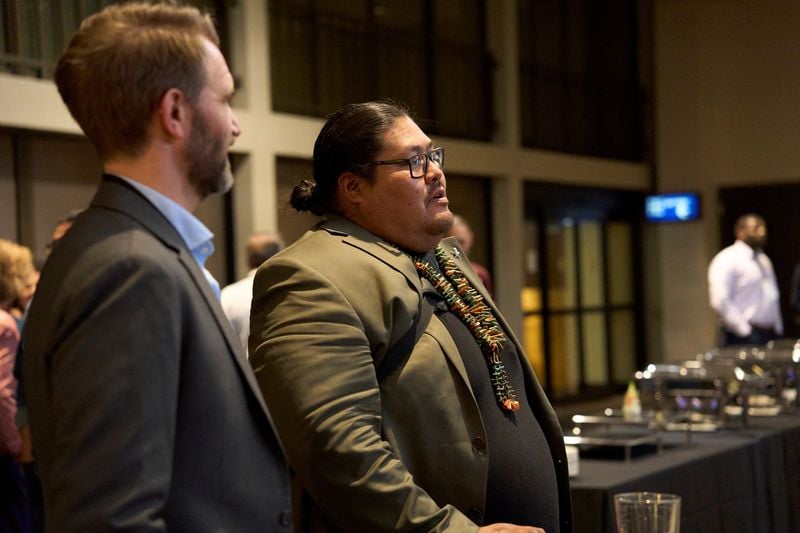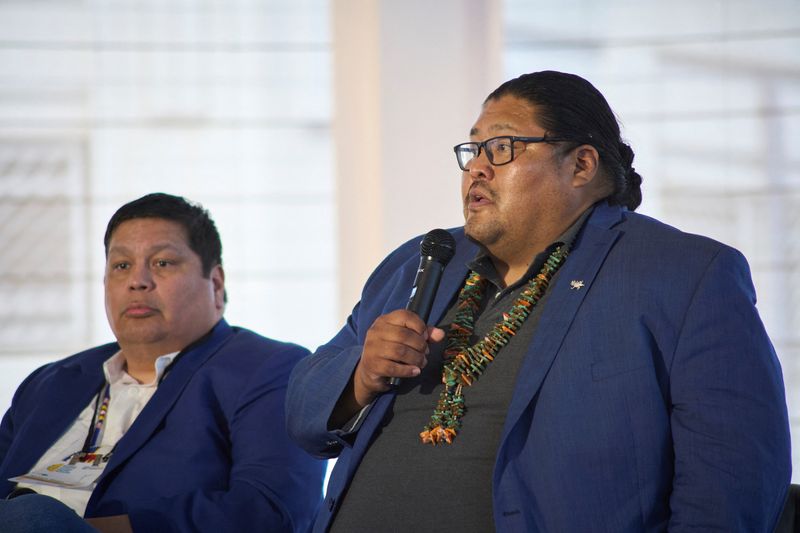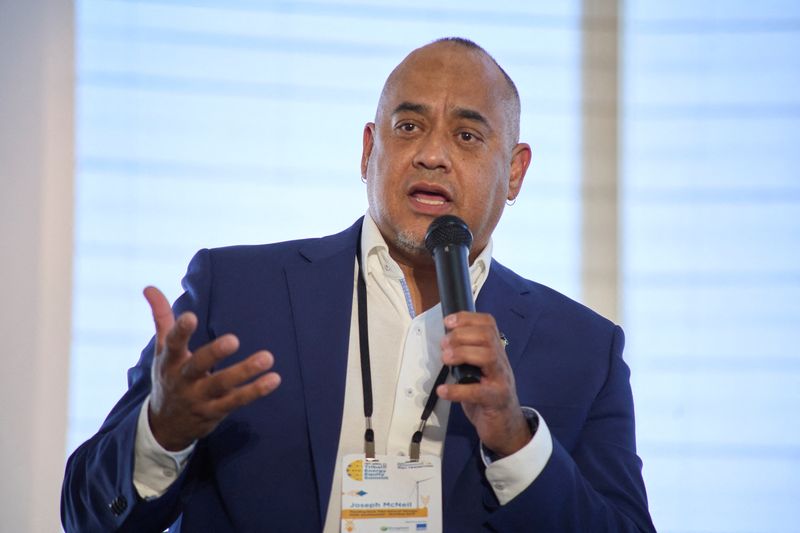By Valerie Volcovici
(Reuters) – The Standing Rock Sioux reservation near the border of North and South Dakota has some of America’s most powerful winds, with 20 mile an hour (mph) gusts regularly scouring its vast plains.
The tribe in 2020 launched a plan to harness that energy with what would be the country’s first tribal owned utility-scale wind farm – a project meant to supply jobs, money and electricity to a place where those things are in short supply.
The project is at the heart of the Standing Rock Sioux’s long-term economic strategy, and revenue from selling power to the regional grid would replace the reservation’s casino, which nets around $6 million per year, as the biggest source of revenue.
The bipartisan infrastructure bill and Inflation Reduction Act (IRA) enacted over the last two years have created enormous opportunities to develop wind and solar projects on tribal lands, offering around $14 billion in subsidies and incentives. The IRA also allows tribes and other tax-exempt entities to access the incentives in the form of a direct payment, instead of a typical tax break.
But, unlike the wind blowing across the Great Plains, the project is going nowhere fast.
Tribes cannot access key incentives for larger clean energy projects until they secure an agreement to connect to the regional electrical grid. That is an expensive process that can take years and requires technical expertise that most tribes lack. Other incentives provided under the legislation expire as early as 2024 and 2026.
That could jeopardize a “once in a lifetime opportunity,” according to Cheri Smith, president of the Alliance for Tribal Clean Energy, a nonprofit that is helping tribes develop clean energy.
“All of that money isn’t going to do its job unless we remove these roadblocks,” Smith said.
The Standing Rock Sioux’s project is one of around a dozen larger-scale clean energy projects proposed by tribes seeking to take advantage of new federal green energy subsidies, according to Reuters interviews with over two dozen tribal representatives, government officials and industry experts. The projects combined would produce at least 4GW of electricity.
Those tribal leaders said half of these projects are slogging through the grid connection queue, with the rest yet to begin the process, reflecting the difficulties small developers face navigating the grid interconnection process and accessing IRA incentives.
The tribes interviewed by Reuters say that, unlike their bigger corporate rivals, tribes lack the upfront capital and internal know-how to navigate the regulatory hurdles to building and connecting a major power project to the grid.That means the tribes – who are among the poorest communities in the country – could miss out on a big development opportunity, and the United States could miss out on their substantial potential to generate renewable energy at a time of huge demand for climate-friendly power.
A Treasury Dept official told Reuters it held four formal consultations with tribes as it developed the IRA provisions. The official acknowledged the financial constraints on tribes in the predevelopment stage, but said that the IRA does not allow the release of funds before interconnection agreements are secured.
“In the short term it will take time for projects to get off the ground and for tribes to figure out how to use the credits but it’s a significant opportunity,” the official said.
The Standing Rock Sioux have so far spent $3 million on technical studies and fees to remain in the queue, with no guarantee of approval. More deposits ranging from $1 million to $10 million may be forthcoming.
That could amount to a missed opportunity: Tribal lands account for around 6.5% of the country’s renewable energy potential, according to the National Renewable Energy Laboratory. Yet Native American households lack access to electricity at far higher rates than the national average, according to the Energy Information Administration. Only 30% of the Navajo Nation reservation has electricity despite being surrounded by large cities like Phoenix.
A NEW DAY
The Standing Rock Sioux tribe’s development authority, called SAGE, proposed the 235MW wind farm three years ago. They named the project Anpetu Wi, which means “the beginning of a new day” in the Lakota language.
The tribe led massive protests against the Dakota Access oil pipeline in 2016 that drew international support and attention.
SAGE estimates the wind farm will bring in $210 million of revenue over 25 years from the sale of power to the regional grid, creating dozens of direct jobs and more indirectly over time as the tribe invests in new initiatives.
More money and jobs would help the tribe, which suffers from 50% unemployment and a 37% poverty rate, according to the Interior Department and Census data, driven in part by high electricity rates.
The cost of electricity on the reservation is double that in nearby Bismarck, North Dakota, according to SAGE director Joe McNeil.
“Energy inequity has been a core driver of this economic disparity,” McNeil said.
He said the tribe could control electricity prices if it owned Anpetu Wi. Wind farm revenue would be reinvested in local distributed solar energy and microgrid projects that would lower tribal electricity bills, and fund other projects like regenerative agriculture and a cultural museum.
So far, the tribe has secured a site and completed studies on its wind potential and the cultural and environmental impacts as part of the process of securing a connection agreement from the regional grid operator, the Southwest Power Pool, one of seven non-profit transmission organizations in the U.S. charged with ensuring reliable power supply in its region.
McNeil said the project is in the middle of the pack in the Southwest Power Pool’s queue of over 400 projects.
The SPP did not respond to requests for comment.
The tribe raised much of the $3 million it has spent so far from philanthropies and family funds, including the Sierra Club Foundation, Wallace Global Fund, and the Bush Foundation in the form of forgivable loans.
Eileen Briggs, grantmaking director for the Bush Foundation, said the risk is worthwhile, given the potential impact if the project succeeds.
“Beyond the impacts for Standing Rock Sioux, tribal nations across the country will have a proven example of how to develop and own renewable power systems,” she said.
She said that without philanthropic support, highly capital intensive projects “can effectively shut out anyone but the largest, most established developers.”
Other tribes are facing such obstacles.
Navajo Power, a project developer that works with tribal governments, has five proposed clean power projects in the queue for interconnection, including one initiated three years ago.
It too has sought out philanthropies and family funds to get the projects through permitting and interconnection, said Brett Isaac, CEO of Navajo Power.
“The pre-development phase [is] the most risky phase, where tribes themselves just don’t have the stomach in their investment risk tolerance,” he said.
The Moapa Southern Paiute in Nevada, meanwhile, are developing nearly 2GW of solar power to sell to large markets like Las Vegas. But the tribe opted for land-lease instead of ownership because of the difficulties in accessing upfront capital.
“We want ownership so badly we can taste it,” said Greg Anderson, chairman of the tribe.
GOVERNMENT TALKS
In May, the Alliance’s Smith, a former executive at Tesla Solar City, convened a closed door gathering in St. Paul, Minnesota of 20 officials from the Federal Energy Regulatory Commission; over a dozen officials from the Energy and Interior Departments, and dozens of tribal energy leaders from around the country to address the obstacles faced by the tribes. Reuters attended the conference.
Jeremiah Baumann, chief of staff to the Under Secretary for Infrastructure at DOE, told the meeting the agency’s loan energy programs have not been effective in helping the tribes. “Too many programs have been too hard to access; the administrative burdens are too high,” he said.
Acting FERC Chairman Willie Phillips told the meeting that FERC was working to address the backlog of projects in the interconnection queue. FERC enacted broad reforms two months later but these did not specifically address the problems of upfront capital mentioned by the tribes.
The Alliance’s Smith said she would ask FERC to drastically reduce deposits and interconnection costs for tribes and give priority to tribal projects in the queue.
A FERC spokesperson said the commission plans to continue getting input from tribal governments. “This rule is just the beginning of the Commission’s transmission reform process. There is more to come,” spokesperson Celeste Miller said.
Smith said she hopes federal agencies do not miss the chance to incorporate tribal feedback.
“Electricity cannot be a privilege. It’s a right and for us to have a truly just transition, it is essential that it be guided by Native people, for Native people,” she said.
(Reporting by Valerie Volcovici; Editing by Richard Valdmanis and Suzanne Goldenberg)


